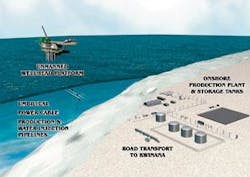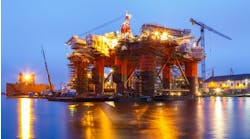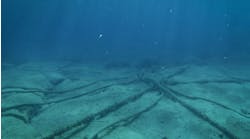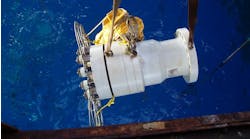Ian Ayling
Centrilift
a Division of Baker Hughes
ROC Oil has selected Centrilift’s electrical submersible pump (ESP) systems for its Cliff Head field development project offshore Western Australia. The $170.6 million project, ROC’s first offshore field in Australia’s Perth basin, lies in an environmentally sensitive area, among limestone reefs, beds of sea grass and close to one of the regions main whale migration routes.
With environmental protection high on the agenda and every effort being taken to minimize the impact of the project, ROC Oil stipulated that be no produced water discharge from the development, which also sits in the middle of a major rock lobster fishery.
The Cliff Head development, located 11 km from shore and in 18 m of water, is the first oil field to be developed off the Western Australian coast south of the Exmouth sub-basin, some 1,000 km to the north.
Cliff Head field schematic.
“Despite its modest size, the development of the Cliff Head oil field is an important landmark for the offshore oil industry in Western Australia,” states ROC Oil’s CEO, Dr. John Doran. “The Cliff Head development will establish significant onshore and offshore infrastructure in the region. This may prove to be relevant in the event that further fields are discovered and developed in and around the Cliff Head oil field and in the adjoining coastal area.”
Due to the region’s environmental sensitivity, the Cliff Head platform is designed for remote operation from a purpose-built onshore base 14 km away. The platform is totally unmanned, apart from periods for workovers and routine maintenance, and can only be accessed by helicopter for a maximum of nine hours a day.
The onshore facility, located on a site formerly occupied by a lime plant, houses much of the equipment traditionally sited on the platform itself. Power is supplied to the platform via an umbilical with an 11-kV stepdown transformer, which feeds the 415-V supply to the variable speed drives (VSDs).
At peak production, Cliff Head will produce up to 15,000 b/d from six production wells, all of which are installed with Centrilift’s Electrocoil coil tubing deployed ESP systems, with an additional two wells being used for produced water reinjection.
The field, which features both proven and probable recoverable reserves, is estimated to be in the order of 14 MMbbl of crude - 32 ̊API with a gas-to-oil ratio 31 scf/bbl. The crude is of a waxy nature (wax appearance temperature 45°C) and requires scale inhibitor and de-emulsifier injection from the outset.
It is expected the produced oil will be trucked to the BP oil refinery at Kwinana, approximately 350 km south of Perth.
The production wells are also highly deviated, with a number planned as horizontal wells.
Due to the need to minimize offshore infrastructure, coiled tubing deployment was recognized as the best solution for ESP deployment.
Featuring the power cable firmly secured inside the tubing and using a mechanical anchoring system, the Electrocoil overcomes cable slippage, therefore eliminating a potential failure mechanism associated with coiled tubing deployed ESPs.
“Our Electocoil system has been developed specifically to allow operators to realize the combined benefits of ESPs and coiled tubing deployment. It is the ideal solution for Cliff Head where minimal infrastructure and speed of deployment are important factors,” comments Ian Ayling, Centrilift project manager.
The Centrilift scope of work includes all aspects of ESP system design, manufacturing, installation and operation. In addition to the ESPs and VSDs, Centrilift is also supplying ROC Oil with the upper completion components and downhole monitoring system. Make-up water for the injection wells is produced from an onshore well using a different specification Centrilift ESP.
Because of the scale and complexity of the development, in particular the challenging workovers, timely equipment supply and coordination between the various suppliers to the project is paramount.
“With a development of this scale, a challenge for everyone involved is managing the critical interfaces between the various project elements. For Centrilift this means that we not only have to manage our own internal and supplier interfaces, but we also need to consider the work being done by the company responsible for the platform, the tree, power supply generation systems and the coil tubing unit vendors -- equipment which is all integrally linked with the Centrilift scope and operations,” says Ayling.
“Everything is being done to ensure that we meet the minimum three-year run life targets that the project’s economics require. We have finalized the ESP system design and are currently in the manufacturing stage. Prior to installation we will hold a full system stack test to verify procedures and allow operator personnel to gain familiarity with the equipment. This approach has been very successful on other projects and is central to our philosophy for the Cliff Head development.”•




